Microcatheters Market by Type (Delivery, Diagnostic, Aspiration, Steerable), Design (Single, Dual), Application (Cardiovascular, Neurovascular, Peripheral Vascular, Oncology), End-User (Hospitals, Ambulatory Surgical Centers) - Global Forecast to 2028
Updated on : July 05, 2023
The global microcatheters market in terms of revenue was estimated to be worth $874 million in 2023 and is poised to reach $1,142 million by 2028, growing at a CAGR of 5.5% from 2023 to 2028. The new research study consists of an industry trend analysis of the market. The new research study consists of industry trends, pricing analysis, patent analysis, conference and webinar materials, key stakeholders, and buying behaviour in the market. Rising demand for image-guided interventions and Increasing investment in healthcare infrastructure are a few drivers that collectively contribute to the growth of the microcatheters industry, and as healthcare technologies continue to evolve, the demand for microcatheters is expected to rise further in the coming years. However, higher initial high investment cost limits the entry of new participants and market growth.
Attractive Opportunities in the Microcatheters Market
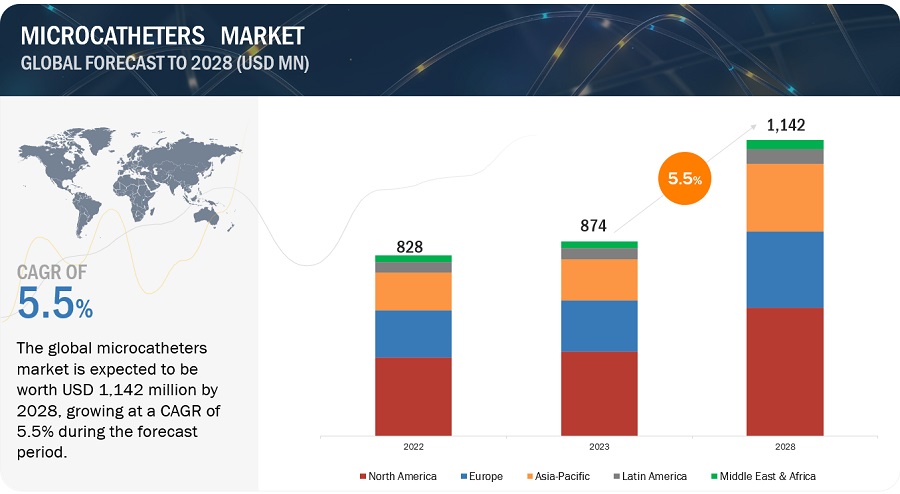
To know about the assumptions considered for the study, Request for Free Sample Report
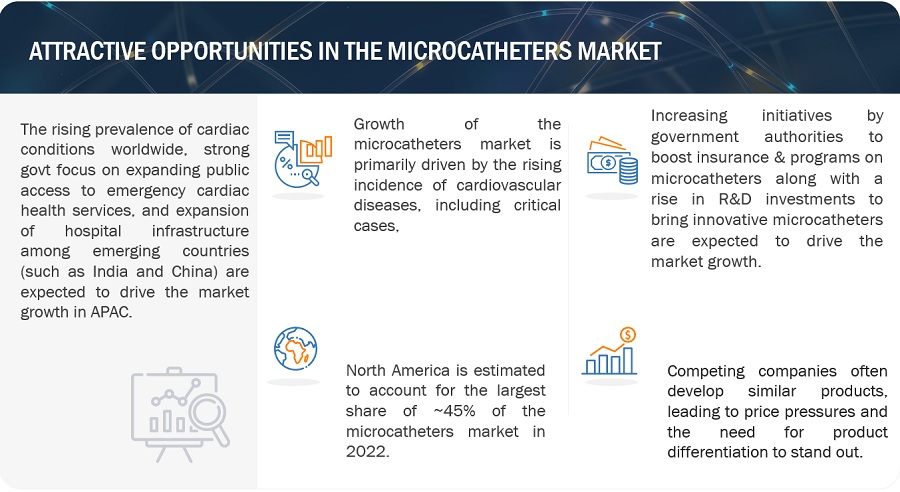
Microcatheters Market: Market Dynamics
Driver: Increasing Prevalence of Chronic Diseases
The rising incidence of chronic diseases such as cardiovascular diseases, neurovascular disorders, and cancer drives the demand for microcatheters. These conditions often require minimally invasive interventions, where microcatheters play a critical role.
Growing Aging Population:
The global aging population is a significant driver of the microcatheter industry. Older individuals are more susceptible to various medical conditions, including those that require interventional procedures. The aging demographic fuels the demand for microcatheters as a key tool for diagnosis and treatment.
Advancements in Minimally Invasive Techniques:
The development of advanced minimally invasive techniques has revolutionized medical procedures. Microcatheters enable physicians to navigate through intricate anatomical structures with precision and perform targeted interventions. The demand for microcatheters is driven by the desire for less invasive procedures that offer reduced patient trauma and faster recovery times.
Technological Innovations:
Ongoing advancements in microcatheter technology contribute to market growth. Manufacturers are continuously improving catheter design, materials, flexibility, and trackability. These innovations enhance the performance, safety, and efficacy of microcatheters, leading to increased adoption in medical procedures.
Restraint: Stringent Regulatory Requirements
Microcatheters are classified as medical devices and are subject to rigorous regulatory scrutiny and approval processes in many countries. Compliance with regulatory requirements, such as obtaining necessary certifications and clearances, can pose challenges and lead to delays in product launches or market entry.
High Cost of Microcatheters:
Microcatheters can be relatively expensive due to their advanced technology, specialized materials, and manufacturing processes. The high cost of microcatheters can limit their adoption, especially in regions with limited healthcare budgets or where reimbursement may be inadequate. Cost considerations can also affect the willingness of healthcare providers to invest in newer and more advanced microcatheter models.
Limited Availability in Developing Regions
Microcatheters may be less accessible in certain developing regions due to factors such as limited healthcare infrastructure, lack of trained healthcare professionals, and challenges in the distribution and supply chain. The availability and adoption of microcatheters may be constrained in these regions, impacting market growth.
Potential Risks and Complications
While microcatheters offer several advantages, there are potential risks and complications associated with their use. These can include vessel perforation, thrombosis, infection, or embolism. Concerns about these risks and complications may influence the adoption of microcatheters and lead to cautious utilization by healthcare providers.
Opportunity: Technological Advancements
Continued advancements in microcatheter technology offer opportunities for product innovation and differentiation. Companies can develop microcatheters with improved flexibility, trackability, and visibility under imaging guidance. Integration of technologies like robotics, advanced materials, and enhanced catheter navigation systems can further enhance the capabilities of microcatheters and open new avenues for growth.
Emerging Markets
There is significant growth potential for microcatheters in emerging markets. As healthcare infrastructure improves and disposable incomes rise in these regions, the demand for advanced medical procedures, including interventional treatments, is increasing. Companies can expand their presence in these markets by offering cost-effective, high-quality microcatheters tailored to local needs.
Expansion in Applications
Microcatheters have traditionally been used in cardiovascular and neurovascular interventions. However, there are opportunities to expand their applications into other medical specialties, such as urology, oncology, and gastroenterology. Companies can develop specialized microcatheters to address the specific needs of these fields and tap into new market segments.
Increasing Adoption of Minimally Invasive Procedures:
The trend towards minimally invasive procedures is expected to continue, driven by patient preference for less invasive treatments and healthcare cost containment. Microcatheters play a vital role in enabling these procedures, presenting opportunities for companies to provide innovative solutions that improve procedural outcomes and patient experiences.
Collaboration and Partnerships
Collaborations between medical device manufacturers, healthcare providers, and research institutions can drive innovation and accelerate market growth. Partnerships can facilitate the development of new microcatheter technologies, expand market reach, and foster knowledge exchange to address unmet clinical needs.
Challenge: Competitive Landscape
The microcatheters industry is highly competitive, with numerous manufacturers vying for market share. Competing companies often develop similar products, leading to price pressures and the need for product differentiation to stand out. The presence of established players with strong brand recognition can make it challenging for new entrants to gain market traction.
Cost Pressures
Microcatheters can be relatively expensive due to their advanced technology, specialized materials, and manufacturing processes. The high cost of microcatheters can limit their adoption, especially in regions with limited healthcare budgets or where reimbursement rates may not adequately cover the expenses. Cost considerations can also affect the willingness of healthcare providers to invest in newer and more advanced microcatheter models.
Product Complexity and Variability
Microcatheters come in various shapes, sizes, and specifications to address different clinical needs. The wide range of product options can lead to complexity in product selection, training, and inventory management for healthcare providers. The need to ensure proper product knowledge and compatibility with other devices can pose challenges for clinicians.
Training and Skill Requirements
The effective use of microcatheters requires specialized training and expertise. Healthcare professionals need to acquire the necessary skills to navigate through complex anatomical structures and perform procedures safely. Ensuring the availability of comprehensive training programs and opportunities for skill development can be a challenge, particularly in regions with limited access to training resources.
MICROCATHETERS MARKET ECOSYSTEM
Major companies in this market include well-established and financially stable suppliers of microcatheter systems, reagents, gel documentation systems, and software. Prominent companies in this market include Boston Scientific Corporation Massachusetts, US), Medtronic plc (Dublin, Ireland), Terumo Corporation (Tokyo, Japan), Johnson & Johnson (New Jersey, US), Cook Medical Inc. (Indiana, US), Abbott Laboratories (Illinois, US), B. Braun Melsungen AG (Melsungen, Germany), Cardinal Health, Inc. (Ohio, US) among several others.
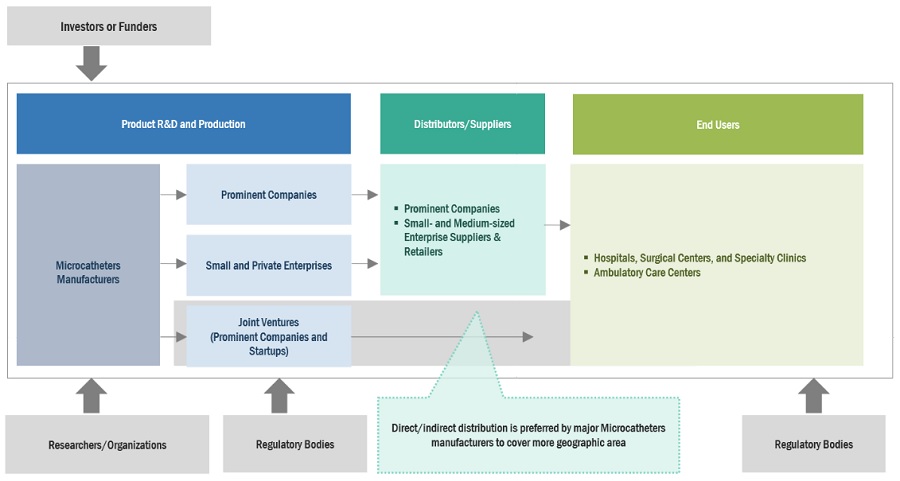
Delivery Microcatheters segment of the Microcatheters Industry to register significant growth rate over the forecast period of 2022-2028
Based on the product type, the microcatheters market is segmented into Delivery Microcatheter, Aspiration Microcatheter, Diagnostic Microcatheter, and Steerable Microcatheter. Delivery Microcatheters segment to register a significant growth rate over the forecast period of 2022-2028. delivery microcatheter drivers typically consist of the following components. Handling, the handle of the driver provides a comfortable grip for the physician or operator to hold and control the device. It may have ergonomic features or finger grips to enhance maneuverability. Steerable Tip: The distal end of the driver features a steerable tip that can be deflected or angled to navigate through tortuous vascular pathways. The tip may be made of flexible materials or contain shape-memory alloys that allow it to be shaped and re-shaped as needed. This, among other factors, is expected to drive the growth of the segment.
The cardiovascular application segment accounted for the largest share of the Microcatheters Industry in 2022-2028
Based on the application, the Microcatheters market is segmented into Cardiovascular, Neurovascular, Peripheral Vascular, Urology, Otolaryngology, and other applications. Microcatheters enable physicians to perform complex cardiovascular interventions using minimally invasive techniques. Compared to traditional open surgeries, minimally invasive procedures offer several advantages, including reduced trauma, shorter hospital stays, faster recovery, and improved patient outcomes. Microcatheters facilitate the delivery of therapeutic agents, devices, and embolic materials to precise locations within the cardiovascular system, allowing physicians to treat blockages, malformations, or other conditions without the need for extensive surgical procedures. The increasing preference for minimally invasive approaches in cardiovascular interventions drives the demand for microcatheters.
The single-lumen microcatheter segment accounted for the largest share of the microcatheters industry in 2022-2028
Based on the design, the microcatheters market is segmented into single-lumen microcatheter and Dual Lumen Microcatheter. The single-lumen microcatheter design segment is estimated to hold the largest market share of the microcatheters industry during the forecast period.
This segment held a share of 91.7% in 2022. As the global population continues to age, there is a rise in the incidence of age-related medical conditions, such as cardiovascular diseases and neurovascular disorders. Single-lumen microcatheters are frequently utilized in the diagnosis and treatment of these conditions. The expanding aging population contributes to the market growth of microcatheters.
Hospitals, Surgical Centers, and Specialty Clinics’ segment to register for the highest growth rate of the microcatheters industry in 2022-2028
The major end users in the microcatheters market are hospitals, surgical centers & specialty clinics, and ambulatory surgical centers. hospitals, surgical centers, and specialty clinics are expected to dominate the market during the forecast period. Microcatheters have become an integral part of many interventional procedures, such as angiography, embolization, and percutaneous interventions. As medical technology advances, there is an increasing trend towards less invasive procedures, and microcatheters play a vital role in enabling these minimally invasive techniques. Hospitals may expand their use of microcatheters to keep up with the growing demand for interventional procedures.
North America is expected to be the largest region of the Microcatheters Industry during the forecast period.
North America, comprising the US and Canada, held the largest share of the microcatheters market in 2022. This region is witnessing a surge in demand for microcatheters to address and manage cardiovascular diseases, which is further amplified by the growing number of surgical procedures involving microcatheters.
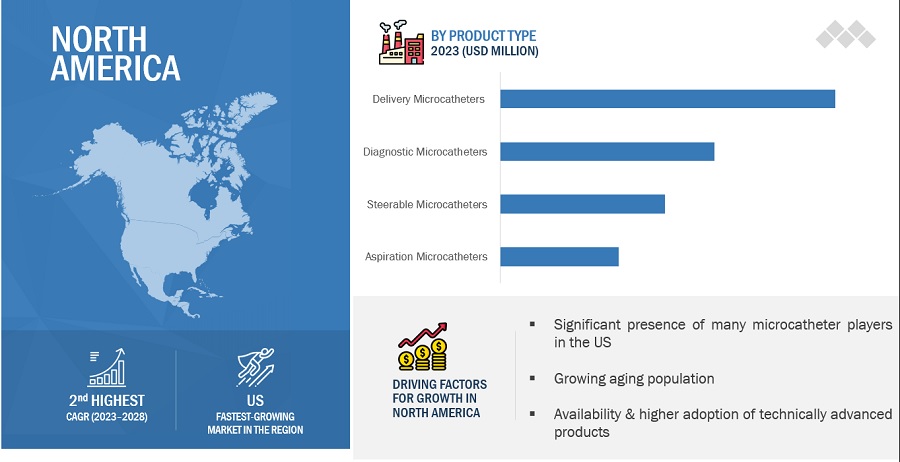
To know about the assumptions considered for the study, download the pdf brochure
As of 2021, prominent players in the market are Boston Scientific Corporation. (US), Stryker Corporation (US), Teleflex Incorporated (US), Cook Group (US), Becton Dickinson and Company (US), and Asahi Intecc Co.ltd (Japan), among others.
Scope of the Microcatheters Industry
|
Report Metric |
Details |
|
Market Revenue in 2023 |
$874 million |
|
Projected Revenue by 2028 |
$1,142 million |
|
Revenue Rate |
Poised to Grow at a CAGR of 5.5% |
|
Market Driver |
Increasing Prevalence of Chronic Diseases |
|
Market Opportunity |
Technological Advancements |
This report has segmented the global microcatheters market to forecast revenue and analyze trends in each of the following submarkets:
By Product Type
- Delivery Microcatheter
- Aspiration Microcatheter
- Diagnostic Microcatheter
- Steerable Microcatheter
By Application
- Cardiovascular
- Neurovascular
- Peripheral Vascular
- Urology
- Otolaryngology
- Other Applications
By Product Design
- Single Lumen Microcatheter
- Dual Lumen Microcatheter
By End User
- Hospitals and Clinics
- Ambulatory Surgical Centers
By Region
-
North America
- US
- Canada
-
Europe
- Germany
- France
- UK
- Italy
- Spain
- Rest of Europe
-
Asia Pacific
- Japan
- China
- India
- Australia
- South Korea
- Rest of Asia Pacific
-
Latin America
- Brazil
- Mexico
- MEA
Recent Developments of Microcatheters Industry
- In 2021, Terumo medical corporation introduced a new microcatheter named PG Pro Peripheral Microcatheter.
- In 2020, Tri Saslus introduced TriNav Microcatheter, globally.
Frequently Asked Questions (FAQ):
What is the projected market revenue value of the global microcatheters market?
The global microcatheters market boasts a total revenue value of $1,142 million by 2028.
What is the estimated growth rate (CAGR) of the global microcatheters market?
The global microcatheters market has an estimated compound annual growth rate (CAGR) of 5.5% and a revenue size in the region of $874 million in 2023.
To speak to our analyst for a discussion on the above findings, click Speak to Analyst
This study involved the extensive use of both primary and secondary sources. The research process involved the study of various factors affecting the industry to identify the segmentation types, industry trends, key players, competitive landscape, key market dynamics, and key player strategies.
Secondary Research
The secondary research process involves the widespread use of secondary sources, directories, databases (such as Bloomberg Businessweek, Factiva, and D&B Hoovers), white papers, annual reports, company house documents, investor presentations, and SEC filings of companies. Secondary research was used to identify and collect information useful for the extensive, technical, market-oriented, and commercial study of the microcatheters market. It was also used to obtain important information about the key players and market classification & segmentation according to industry trends to the bottom-most level and key developments related to market and technology perspectives. A database of the key industry leaders was also prepared using secondary research.
Primary Research
In the primary research process, various sources from both the supply and demand sides were interviewed to obtain qualitative and quantitative information for this report. The primary sources from the supply side include industry experts such as CEOs, vice presidents, marketing and sales directors, technology & innovation directors, and related key executives from various key companies and organizations in the microcatheters market. The primary sources from the demand side include medical OEMs, Analytical instrument OEMs, CDMOs, and service providers, among others. Primary research was conducted to validate the market segmentation, identify key players in the market, and gather insights on key industry trends & key market dynamics.
A breakdown of the primary respondents is provided below:
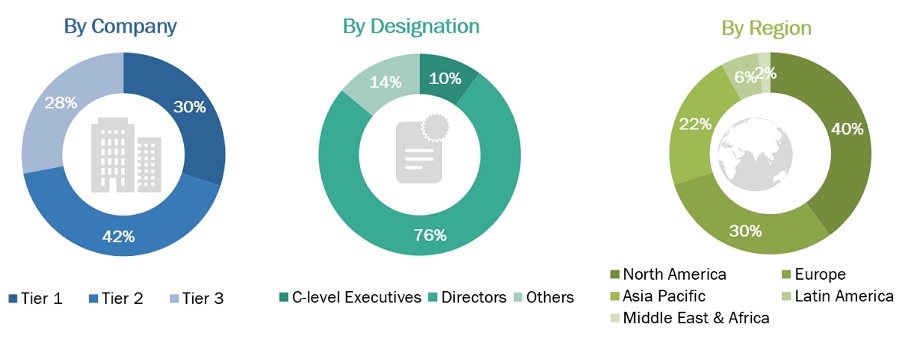
*Others include sales managers, marketing managers, business development managers, product managers, distributors, and suppliers.
Note: Companies are classified into tiers based on their total revenue. As of 2021, Tier 1 = >USD 2 billion, Tier 2 = USD 50 million to USD 2 billion, and Tier 3 = <USD 50 million.
To know about the assumptions considered for the study, download the pdf brochure
Market Estimation Methodology
In this report, the global microcatheters market size was arrived at by using the revenue share analysis of leading players. For this purpose, key players in the market were identified, and their revenues from the microcatheter business were determined through various insights gathered during the primary and secondary research phases. Secondary research included the study of the annual and financial reports of the top market players. In contrast, primary research included extensive interviews with key opinion leaders, such as CEOs, directors, and key marketing executives.
To calculate the global market value, segmental revenues were calculated based on the revenue mapping of major solution/service providers. This process involved the following steps:
- Generating a list of major global players operating in the microcatheters industry
- Mapping annual revenues generated by major global players from the microcatheters industry segment (or nearest reported business unit/product category)
- Revenue mapping of key players to cover a major share of the global market, as of 2021
- Extrapolating the global value of the microcatheter industry
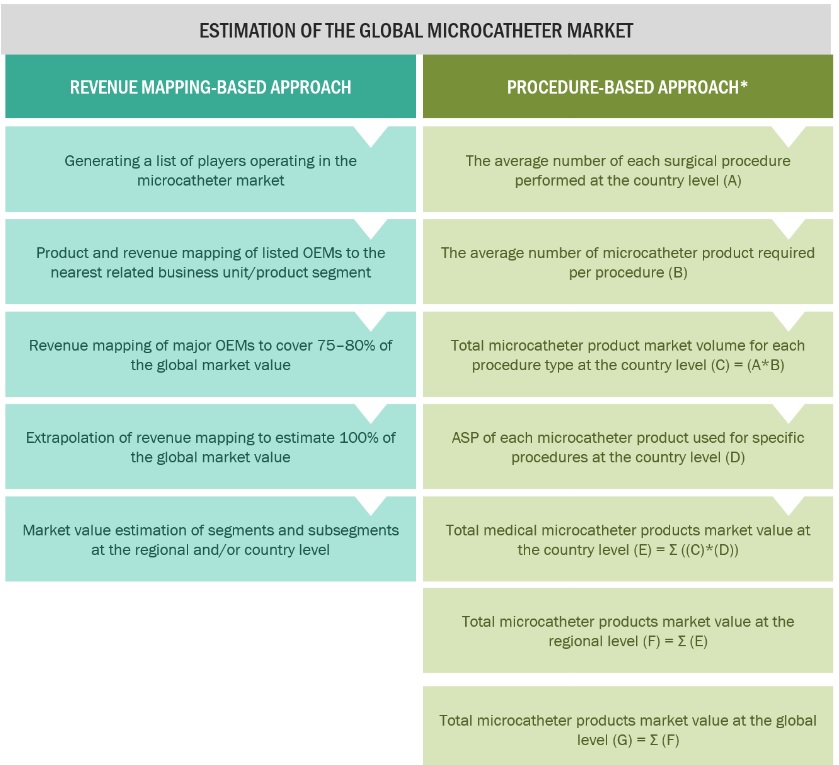
Data Triangulation
After arriving at the overall market size from the market size estimation process explained above, the global microcatheters market was split into segments and subsegments. Data triangulation and market breakdown procedures were employed to complete the overall market engineering process and arrive at the exact statistics for all segments and subsegments. The data was triangulated by studying various factors and trends from both the demand and supply sides. Additionally, the microcatheter industry was validated using both top-down and bottom-up approaches.
Market Definition
Microcatheters are small 0.70-1.30mm diameter catheters that are used for guidewire support, exchanges, to access distal anatomy, cross lesions, deliver therapeutic embolic, inject contrast media and perform other procedures in complex endovascular procedures.
Key Stakeholders
- Manufacturers of microcatheter
- Distributors of microcatheter
- Hospitals, Clinics, Cardiac Centers
- Non-government organizations
- Government regulatory authorities
- Contract manufacturers and third-party suppliers
- Research laboratories and academic institutes
- Clinical research organizations (CROs)
- Government and non-governmental regulatory authorities
Objectives of the Study
- To define, describe, and forecast the microcatheters market on the basis of product, type, application, end-user, and region
- To provide detailed information regarding the major factors influencing the growth potential of the global microcatheter industry (drivers, restraints, opportunities, challenges, and trends)
- To analyze the micro markets with respect to individual growth trends, future prospects, and contributions to the global microcatheters industry
- To analyze key growth opportunities in the global microcatheters industry for key stakeholders and provide details of the competitive landscape for market leaders
- To forecast the size of market segments and/or subsegments with respect to five major regions, namely, North America (US and Canada), Europe (Germany, France, the UK, Italy, Spain, and the RoE), Asia Pacific (Japan, China, India, Australia, South Korea, and the RoAPAC), and rest of the world.
- To profile the key players in the global microcatheters industry and comprehensively analyze their market shares and core competencies.
- To track and analyze the competitive developments undertaken in the global microcatheters market, such as product launches, agreements, expansions, and & acquisitions.
Available Customizations
With the given market data, MarketsandMarkets offers customizations as per the company’s specific needs. The following customization options are available for the present global microcatheters market report:
Product Analysis
- Product matrix, which gives a detailed comparison of the product portfolios of the top fifteen companies.
Company Information
- Detailed analysis and profiling of additional market players (up to 15)
Geographic Analysis
- Further breakdown of the Rest of Europe microcatheters industry into Russia, Belgium, the Netherlands, Switzerland, Austria, Finland, Sweden, Poland, and Portugal among other
- Further breakdown of the Rest of Asia Pacific microcatheters industry into Singapore, Taiwan, New Zealand, Philippines, Malaysia, and other APAC countries
- Further breakdown of the Rest of the world microcatheters industry into Latin America, MEA, and Africa



 Generating Response ...
Generating Response ...







Growth opportunities and latent adjacency in Microcatheters Market